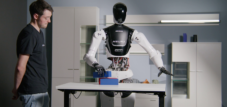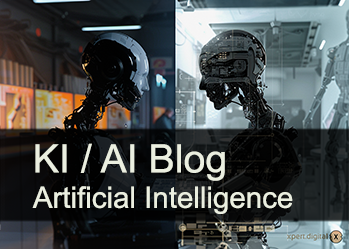United Robotics Group: Promising and exciting new start as a healthcare robotics specialist
Xpert pre-release
Language selection 📢
Published on: October 7, 2025 / Updated on: October 7, 2025 – Author: Konrad Wolfenstein

United Robotics Group: Promising and exciting new start as a healthcare specialist – Image: United Robotics Group
From failure to beacon of hope: A German robotics fairytale? How a new healthcare champion is emerging from the ashes of the URG
Skilled labor shortage in hospitals: Can these robots from Germany be the solution?
It's a story of failure and resurrection that's rare in the German technology landscape: After the initially ambitious plans of the United Robotics Group (URG) ended in insolvency, the company is now relaunching under new leadership and with a radically changed focus. Instead of a broad attempt to create a European champion for all areas of service robotics, the new URG, under the leadership of experienced robotics expert Wassim Saeidi and former Siemens Healthineers manager Kerstin Wagner, is now fully focused on healthcare – the most demanding and simultaneously most needy market.
Driven by the vision of addressing the acute shortage of skilled workers with intelligent, AI-based assistants, the company relies on proven and market-ready products. The centerpiece of the new venture is the mobile laboratory robot uLab Mobile, which already performs repetitive tasks in over 30 laboratories worldwide, relieving the burden on skilled personnel. Supported by solid, organic financing and a clear platform philosophy, URG plans to gradually expand from laboratory automation to logistics and cleaning in hospitals and even direct patient support. With the humanoid robot uMe, announced for 2026, the vision of empathetic, technological support in everyday nursing care will become reality – as an honest solution to a real problem, Made in Germany.
What exactly is the United Robotics Group?
The United Robotics Group (URG) is a German service robotics company headquartered in Stuhr near Bremen, specializing in AI-based robotics solutions for healthcare. The company has had a turbulent history: Founded in 2020 as the European Service Robotics Champion by Thomas Hähn and funded by the RAG Foundation, the original URG filed for insolvency in February 2025. In the summer of 2025, Wassim Saeidi, who had been part of URG since 2019, acquired all patent, trademark, and content rights and is now leading the company with his co-CEO Kerstin Wagner under a new focus.
Why did the original URG have to go bankrupt?
The insolvency of the original United Robotics Group resulted from a confluence of several critical factors. High development costs combined with a lack of profitability placed a significant burden on the company. Ambitious plans to grow rapidly and consolidate various robotics divisions proved more costly than originally anticipated. A decisive turning point was the abrupt suspension of funding by the RAG Foundation in the summer of 2024, which had previously acted as the main investor. The difficult market situation in the German robotics industry, which recorded a ten percent decline in sales in 2025, further exacerbated the already tense situation. The company's structure was also particularly problematic: While the French subsidiary Aldebaran handled the costly development, the sales proceeds flowed primarily to other parts of the company, leaving too little money available for research and development costs.
Who are Wassim Saeidi and Kerstin Wagner?
Wassim Saeidi is the founder and CEO of WS System GmbH, which he established in 2011 and specializes in Industry 4.0 solutions. In 2019, he and his company joined the URG and renamed it "United Robotics Health & Food GmbH." Saeidi brings extensive expertise in robotics and artificial intelligence, complemented by qualifications as a machine learning engineer. His motivation for acquiring the URG rights stemmed from his original enthusiasm for the vision of combining robotics, AI, and humanity.
Kerstin Wagner joined URG's management team in January 2025 and was appointed Co-CEO and COO in September 2025. She brings nearly three decades of experience in the healthcare and diagnostics industry, including a leading position at Siemens Healthineers as Executive Vice President for Marketing and Commercial Operations. Wagner was responsible for, among other things, the market launch of Siemens Healthineers' flagship diagnostics platform in the EMEA region and is considered an expert in the transformation of the healthcare sector.
Why does the new URG focus on healthcare?
The strategic focus on healthcare is based on several compelling arguments. Healthcare represents the most demanding application area for service robotics – if robots function safely and reliably there, this automatically convinces other industries such as airports, public institutions, and schools. Furthermore, URG already had the most robust and most sought-after market-ready products in this area. The acute shortage of skilled workers in the German healthcare sector is further increasing demand: By 2035, German hospitals will be short at least 600,000 workers. Service robotics offers a concrete solution here by taking over repetitive tasks and freeing up qualified staff for actual patient care.
What makes the uLab Mobile so special?
The uLab Mobile is a mobile, collaborative robot specifically developed for laboratory automation. Its unique feature is its seamless integration into existing laboratory environments without any programming effort – thanks to close collaboration with laboratory equipment manufacturers, the robots are trained before delivery. The robot features intelligent camera systems for object recognition, can distinguish sample tubes based on cap colors, and performs product-specific work steps. With its AI-based software, it works with "skills": It recognizes objects, finds grasping points, opens drawers, and plans work steps independently. These capabilities enable it to operate reliably even in unfamiliar environments. The mobile robot can operate autonomously for approximately three hours and is particularly valuable for night shifts in clinical laboratories, where it can often take over the work entirely on its own.
In which laboratories is the uLab Mobile used?
The uLab Mobile is currently in use in more than 30 laboratories worldwide. It is primarily used in clinical diagnostics, both in hospital labs and in private reference labs where primary care physicians send their samples. Major pharmaceutical companies also use the robot for their laboratory processes. Applications include sample handling, decapping and pipetting, loading and operating laboratory equipment such as centrifuges and analyzers, and performing reflex tests. The intelligent uGO software allows laboratory teams to set up and modify workflows within seconds using drag and drop.
What plans does the URG have beyond laboratories?
The new URG is pursuing a systematic expansion strategy based on its successful laboratory operations. Initially, the company intends to expand into other hospital areas, such as catering, material transport, or cleaning. In the long term, URG aims to move from pure object handling to direct patient contact. The plan is to offer nursing support and patient-assisted measures using the same robot platform, with only the grippers and workflows being adapted, while the technical basis remains the same. This platform and family concept enables the cost-effective transfer of proven technology to new application areas.
What is the humanoid robot uMe?
The humanoid robot uMe represents URG's next major development step and is scheduled to be presented at CES in Las Vegas in early 2026. Unlike many other vendors, who often only present visions, the uMe prototype is already running on URG's premises and uses the same proven software platform as the uLab Mobile. Initially, uMe will master the same use cases as the uLab Mobile: object recognition, grasping, and transport from point A to point B. The key difference lies in its ability to climb stairs and thus reach areas inaccessible to mobile robots. The primary goal is its use in senior and nursing care support, including in the home, where uMe will not only provide simple assistance but also interact empathetically with patients.
How is the new URG financed?
The new URG is currently fully self-financed and growing organically based on concrete, ready-to-use products that have already achieved market acceptance. This self-financing is possible because the funds from the previous investor were used to develop solutions that are already marketable. Although the company is in talks with investors, it is in a comfortable exploratory phase without any time pressure. Partnerships are being explored for new ideas and faster growth, but financial independence allows for strategic decisions to be made in peace.
What is the URG’s vision for the next five years?
URG has set itself an ambitious goal: to become a leading European provider of service robotics – a unicorn with an international footprint. This vision is based on its successful product portfolio and its consistent platform and family philosophy. The company aims to set trends by combining AI with real practical benefits and bringing robotics to where people need it: in hospitals, care facilities, and public spaces. Ethics remains a guiding principle – URG stands for technology that protects, relieves stress, and improves lives. Made in Germany stands for the highest quality and reliability.
Our EU and Germany expertise in business development, sales and marketing
Industry focus: B2B, digitalization (from AI to XR), mechanical engineering, logistics, renewable energies and industry
More about it here:
A topic hub with insights and expertise:
- Knowledge platform on the global and regional economy, innovation and industry-specific trends
- Collection of analyses, impulses and background information from our focus areas
- A place for expertise and information on current developments in business and technology
- Topic hub for companies that want to learn about markets, digitalization and industry innovations
Made in Germany: How the new URG is rethinking healthcare robotics
How does the new URG differ from the original?
The new URG differs fundamentally from its predecessor in its clear focus on healthcare, instead of the original broad diversification strategy. While the original URG, under Thomas Hähn, attempted to create a European service robotics champion through rapid acquisitions and consolidation of various robotics areas, the new URG focuses on proven, market-ready products. The financing strategy has also changed fundamentally: Instead of relying on major external investors such as the RAG Foundation, the company finances itself organically from its own revenues. The new management structure, with Saeidi and Wagner, brings both technical expertise and in-depth healthcare know-how, enabling targeted market development.
What role does AI play in URG robots?
Artificial intelligence lies at the heart of URG robot technology and distinguishes its products from simple automation solutions. The AI-based software enables the robots to work with "skills": They recognize objects independently, find optimal gripping points, open drawers, and plan complex work steps independently. This intelligence allows the robots to operate reliably even in unfamiliar environments and adapt to changing conditions. The same AI platform runs on various robot types—from the uLab Mobile to the uClean cleaning robot to the uLog transport robot—creating synergies and reducing development costs. As a machine learning engineer, Saeidi himself brings extensive AI expertise and ensures the continuous development of the intelligent functions.
Why is the URG focusing on humanoid robots despite recent disappointments in the industry?
The URG counters the skepticism surrounding humanoid robots with a deliberately honest and realistic approach. While many companies raise exaggerated expectations that lead to disappointment, the URG focuses on bringing honest products to market. The uMe is not intended to be a showpiece, but rather a practical solution to real challenges. The strategy is based on initially transferring proven functions from the uLab Mobile and then gradually expanding them. The focus is on senior citizen and care support, where demographic change and the shortage of skilled workers are creating a real need. The empathetic interaction is intended to encompass more than just technical gimmicks, but rather offer real added value for users.
How is the market reacting to service robotics in healthcare?
The market for service robotics in healthcare is experiencing dynamic growth, driven by the acute shortage of skilled workers. The medical technology and healthcare sectors recorded 36 percent growth worldwide in 2023. Global sales of service robots increased by almost 50 percent to 158,000 units sold. The potential is considered particularly significant in Germany: Nurses spend 40 to 50 percent of their time on administrative tasks rather than caring for patients – this is precisely where robotics can come in. Demand is so high that Wagner speaks of "open doors" among healthcare customers. However, German healthcare facilities still lag behind internationally – Scandinavian countries are significantly further ahead in the use of robots as logistics service providers.
What technical challenges does the URG face?
The URG solves several critical technical challenges in service robotics. Seamless integration into existing workflows is achieved through close collaboration with laboratory equipment manufacturers, allowing robots to be trained even before delivery. The URG meets healthcare safety requirements through comprehensive sensor technology and compliance with the EU Machinery Directive. Intelligent object recognition enables the robots to distinguish samples based on cap colors and perform product-specific work steps. Remote maintenance and augmented reality support ensure minimal downtime. The modular software architecture allows proven skills to be transferred to different robot platforms, reducing development time and costs.
What does the URG’s platform and family concept mean?
The platform and family concept forms the strategic foundation of the new URG and distinguishes it from individual product providers. At the core of this strategy is a common AI-based software platform that runs on various robot types – from the uLab Mobile and the uClean cleaning robot to the uLog transport robot and the future humanoid uMe. This approach makes it possible to transfer previously developed skills such as object recognition, grasping planning, or navigation to different robots. For new application areas, only the grippers and workflows need to be adapted, while the technical basis remains the same. This strategy reduces development costs, accelerates the market launch of new products, and creates synergies between the various robot solutions. Customers benefit from uniform operating concepts and reduced training requirements.
How does the URG position itself in international competition?
URG consciously positions itself as a European alternative to Asian and American competitors with the quality promise "Made in Germany." While many international providers focus on volume production and low prices, URG focuses on the highest quality, reliability, and safety. The combination of German mechanical engineering expertise, attractive design, and innovative AI software is intended to create a unique selling point. In the healthcare sector, where safety and reliability are critical, this quality approach can offer decisive competitive advantages. URG also focuses on genuine practical suitability rather than marketing promises – while many competitors talk about visions, URG can already demonstrate functioning solutions in routine operation.
What role does ethics play in the URG strategy?
Ethics serves as URG's guiding principle and distinguishes the company from purely technology-driven approaches. URG stands for technology that protects, relieves, and improves lives, rather than replacing people. This philosophy is reflected in product development: Robots are intended to free professionals from repetitive tasks so they can concentrate on core patient care. The empathetic interaction of the planned humanoid robot uMe is intended to create real added value for seniors and those in need of care, not simply be a technical gimmick. This fundamental ethical approach is particularly important in the sensitive healthcare sector, where trust and human touch are central. URG sees itself as a partner of medical personnel, not as their competitor.
How is service robotics developing in Germany in general?
The German service robotics industry is undergoing a period of upheaval, with both challenges and enormous growth opportunities. While the industry recorded a ten percent decline in sales in 2025, individual segments such as healthcare are showing strong growth. Although Germany is the fifth-largest market for industrial robotics worldwide, there is still some catching up to do in service robotics. The largest growth areas lie beyond traditional industrial applications, particularly in healthcare, where global growth of 36 percent was recorded in 2023. Demographic change and the acute shortage of skilled workers are creating additional market opportunities: By 2035, there will be a shortage of half a million nursing staff. Collaborative robots and AI integration are considered key technologies for market development.
What happened to the famous robots Pepper and NAO?
The story of the humanoid robots Pepper and NAO is closely linked to the turmoil at URG and highlights the challenges facing the service robotics industry. Originally developed by the French company Aldebaran, both robots became icons of humanoid robotics. SoftBank acquired Aldebaran in 2012 but discontinued Pepper production in 2021. In 2022, URG, under Thomas Hähn, acquired Aldebaran from SoftBank and attempted to revive the robots, but failed to gain market acceptance. Following URG's insolvency, Aldebaran also filed for bankruptcy in February 2025. In July 2025, the Chinese Maxvision Technology Corporation finally acquired the technological assets and property rights of Pepper and NAO. Maxvision plans to continue production in China and utilize French know-how. Aldebaran itself was permanently closed on June 2, 2025.
Suitable for:
- From celebrated champion to insolvency: The United Robotics Group – Why Europe’s most ambitious robot champion failed
What lessons does the new URG draw from the history of its predecessor?
The new URG has learned fundamental lessons from its predecessor's failure and adjusted its strategy accordingly. Instead of the broad diversification originally pursued, the company now focuses on a clearly defined market: healthcare. Its financing strategy has been radically changed – instead of relying on large external investors, growth is generated organically from its own revenues. The new URG relies on proven, market-ready products rather than ambitious development projects with uncertain outcomes. The focus is on genuine practical suitability and honest product promises rather than marketing visions. The platform strategy reduces development risks by reusing proven technologies. This pragmatic approach is intended to avoid past mistakes and enable sustainable growth.
Your global marketing and business development partner
☑️ Our business language is English or German
☑️ NEW: Correspondence in your national language!
I would be happy to serve you and my team as a personal advisor.
You can contact me by filling out the contact form or simply call me on +49 89 89 674 804 (Munich) . My email address is: wolfenstein ∂ xpert.digital
I'm looking forward to our joint project.


























